For ten years, we have conducted an annual survey on the use of building information modeling (BIM) by engineers and designers in the MEP industry. Here is what we learned in 2019:
- The actual use of BIM has not changed greatly over ten years…
- …but, in recent years, respondents appear to be using it less for some purposes…
- …contrary to predictions that BIM usage, in general, would increase.
Complete results from the survey in 2010, 2011, 2012, 2013, 2014, 2015, 2016, 2017, and 2018 are available online.
Jump to a section:
Uses of BIM
Additional Data
Demographics
Conclusion: A Possible Downturn, But No Big Changes
Uses of BIM
Overview
When we started this survey, we were tracking four uses of BIM:
- 3D collision detection
- Automated design and calculations
- Material takeoffs and cost estimating
- Green building design
We also tracked whether some companies use BIM at all.
In 2015, we changed many of the questions to match those we’d asked for 3D collision detection in earlier years: the format changed from a binary answer (“Do you use BIM for ___?”) to a scaling answer (“Select the percentage of your projects that you use BIM for ___.”), and respondents were asked to predict BIM usage for each purpose three years in the future.
We have also been asking about other uses, such as simulation and animation, prefabrication, creating construction documents, and creating a Revit deliverable. Consistently, few respondents have reported using BIM for the first two purposes, or for material takeoffs; therefore, the data for those questions will not be discussed here.
The graph below compiles the results of these questions over the years. By interpreting a 0% response as “No” and all other responses as “Yes,” we can evaluate and compare the popularity of each purpose for BIM usage. 3D collision detection continues to be one of the most common uses, though the top spot has been claimed by automated design since 2018. Also, while automated design has been trending upward, other uses appear to have stagnated or even decreased in recent years.
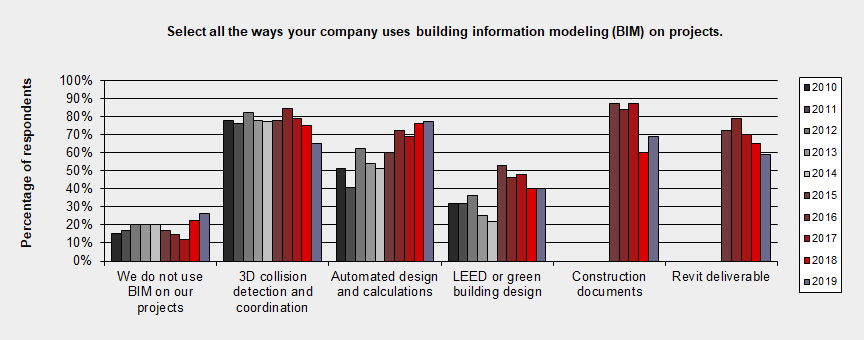
Each use of BIM detailed below has two accompanying graphs:
- A comparison graph of the predicted use three years in the future (taken from the 2016 survey) and the actual use in 2019.
- A historical graph comparing the actual use in 2019 to all previous years.
For these graphs, the x-axis shows the answer the survey respondent gave to the question, while the y-axis shows the percentage of respondents who gave that answer. Using the “Any BIM in 2019” graph below as an example, 26% of respondents used BIM on none of their projects in 2019; 12% of respondents used BIM on all of their projects.
Any BIM On a Project
For this question, we intentionally did not define BIM; it was left to the respondent to decide what “BIM” meant and whether it applied to their projects.
The actual use of any BIM on a project in 2019 largely fell short of the prediction from 2016.
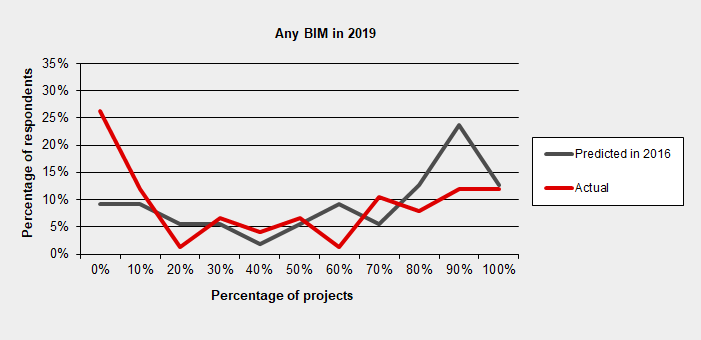
2-5 Person MEP Consultant
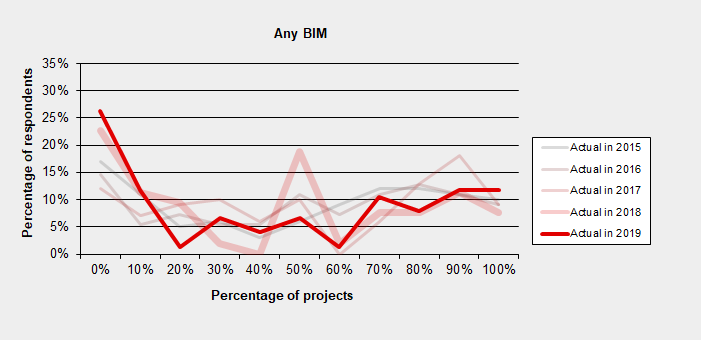
3D Collision Detection
We asked what percentage of projects use BIM for 3D collision detection.
The actual use in 2019 is lower than what was anticipated in 2016. This result has been consistent over the last several years.
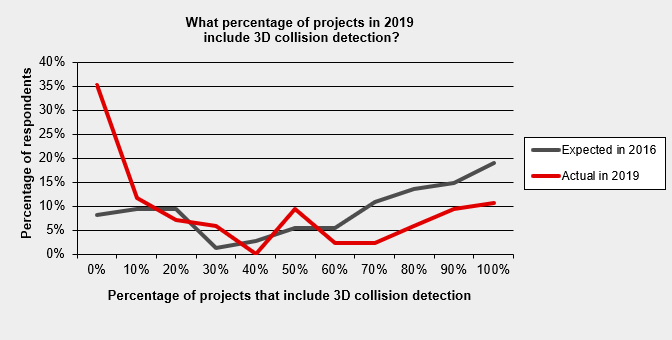
2-5 Person Electrical Consultant
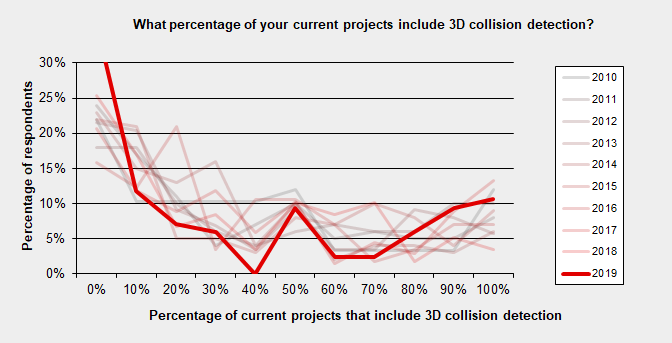
Automated Design and Calculations
The decision to use BIM for automated design and calculations should be independent of anyone else on the project using BIM; sizing ducts, feeders, and pipes can occur whether or not you have an architectural or structural model.
The predicted use from 2016 is relatively close to the actual use, though a little optimistic.
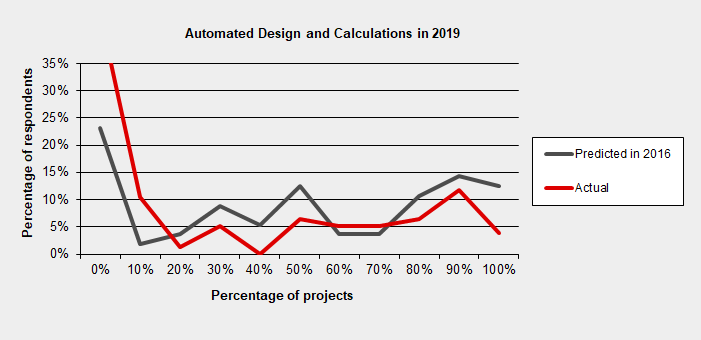
5-10 Person Design Team at a 10-20 Person MEP Design/Build Contractor
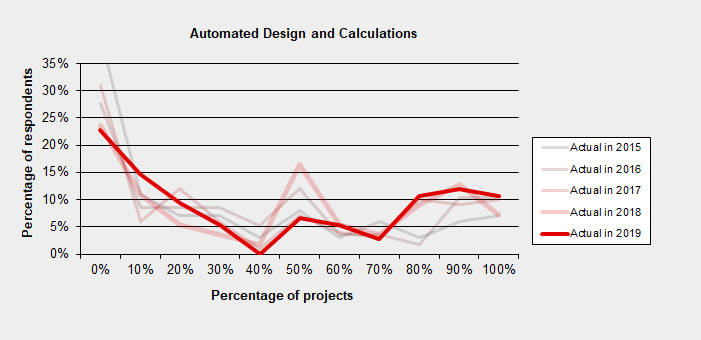
Green Building Design
Green building design is a popular topic, but not a typical use for BIM. A building’s “greenness” is primarily based upon the design decisions of the engineers, for which BIM is not necessary. BIM can be used to model these decisions, but there is nothing about its use that inherently helps make the design greener.
The actual use of BIM for green building design in 2019 is less than was predicted in 2016.
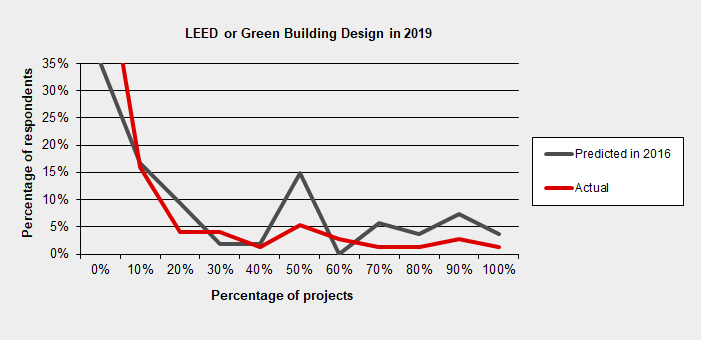
The actual use of BIM for green building design has not changed significantly over the last five years.
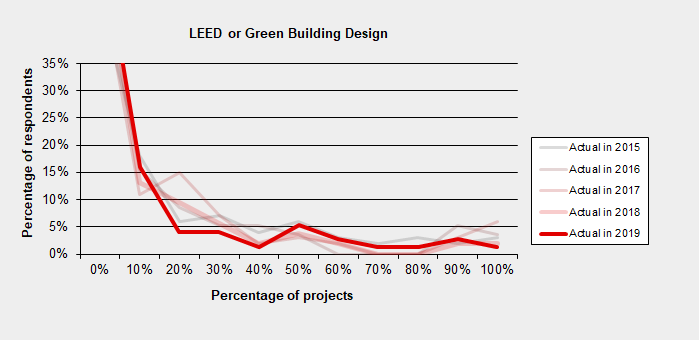
The data support our hypothesis that using BIM for green building design is not a common use, and it will likely stay that way. Green building design is important, but it does not appear to be related to BIM.
Construction Documents
This use of BIM should not depend upon anyone else on the project using BIM. Having a model from the architect can help, but it is not necessary.
The 2016 prediction of using BIM for creating construction documents is relatively accurate to the actual use in 2019, though slightly more favorable than the reality.
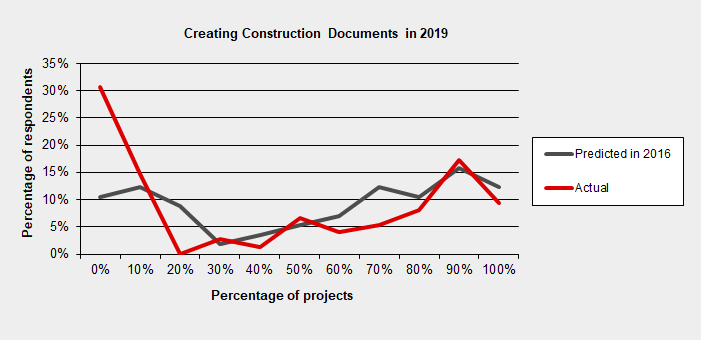
The actual use of BIM for creating construction documents does not show a consistent increase or decrease over five years.
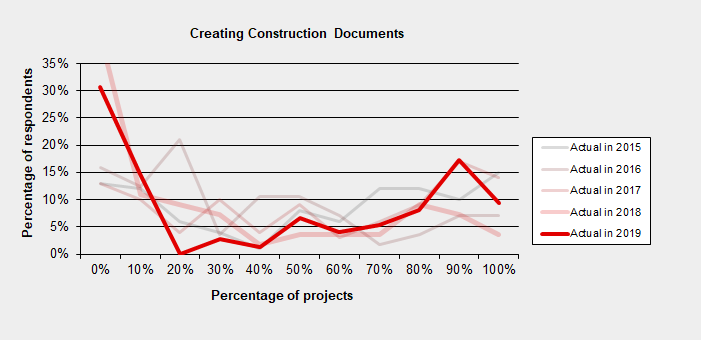
Revit Deliverable
Revit is a specific implementation of BIM. A Revit model is often requested by specific companies and government agencies as a final deliverable for a project.
The actual use of Revit in 2019 is less than the predicted use in 2016.
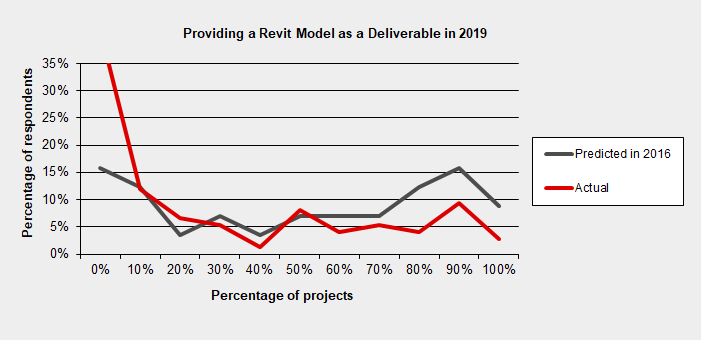
20-50 Person MEP Design Consultant
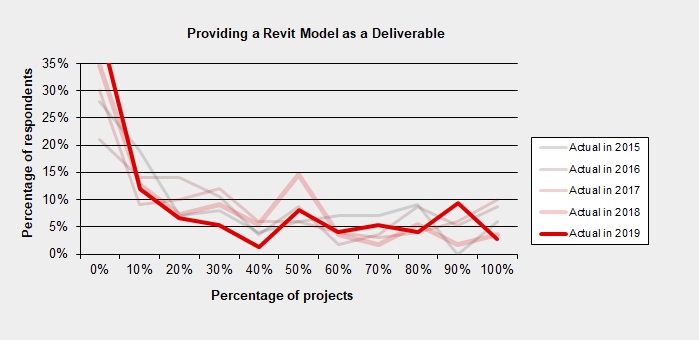
1 Person MEP Consultant
Additional Data
In addition to asking respondents how they use BIM, we also asked the following questions:
- Whether respondents charge additional fees for certain BIM uses
- How often they use BIM (specifically, for 3D collision detection) in relation to other tools
- How often they adjust their design to make it more green or LEED-compliant
Fees
We asked whether respondents charged more when asked to use BIM for the purposes detailed above. For most of them, people generally do not increase their fees. The two exceptions have been using BIM for 3D collision detection and using BIM to deliver a Revit model. Both require additional work from the MEP engineer or designer that does not directly benefit them.
The charts below illustrate the percentage of respondents that increase their fee for 3D collision detection and for providing a Revit deliverable. The numbers have not changed greatly or shown a clear trend compared to previous years.
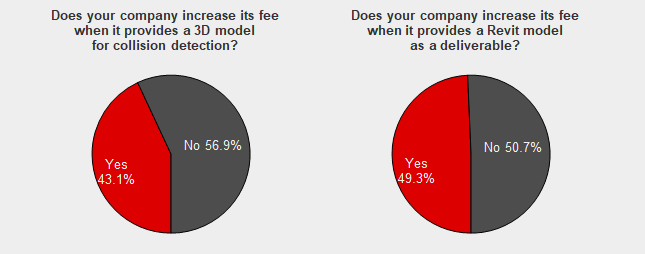
BIM vs. Other Tools
We asked what percentage of projects use AutoCAD and Excel — two of the tools most often used by engineers and designers — and compared the results to the use of 3D collision detection.
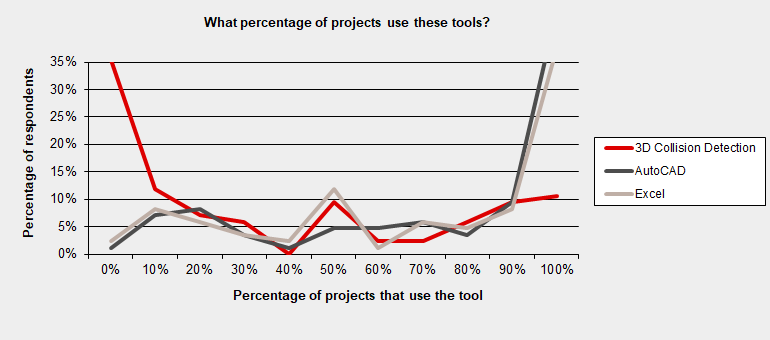
The results reflect our expectation that AutoCAD and Excel are used significantly more than 3D collision detection.
Green Design
We asked what percentage of projects were designed with the intention of making them LEED-compliant or otherwise more green. We have seen that “going green” does not drive the use of BIM; this allows us to see whether it affects designs in general.
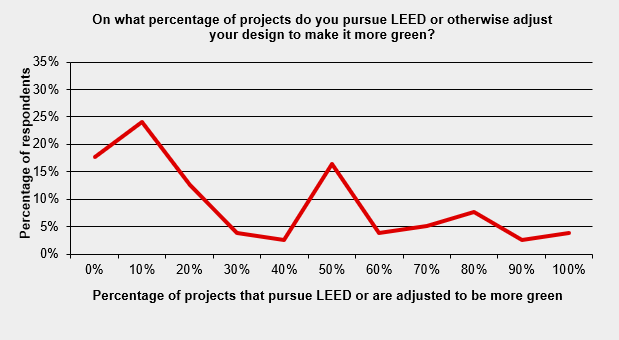
The data show that design decisions, for the most part, are not based upon making the project more green.
Demographics
These results are based upon 85 respondents from the United States and Canada. The handful of respondents from other locations were filtered out of the results.
The following graphs show the size and types of companies where respondents work.
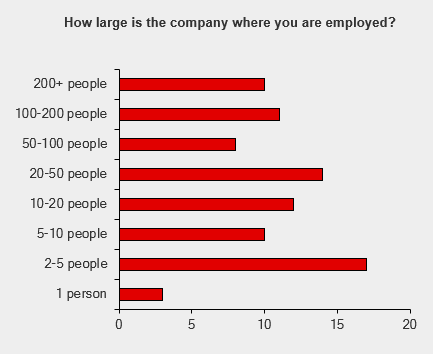
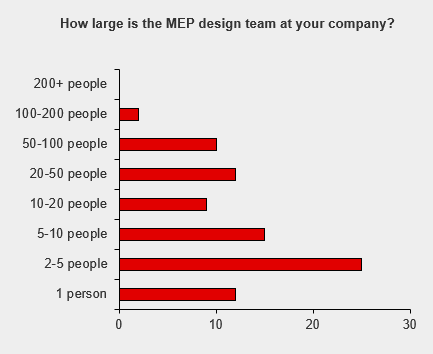
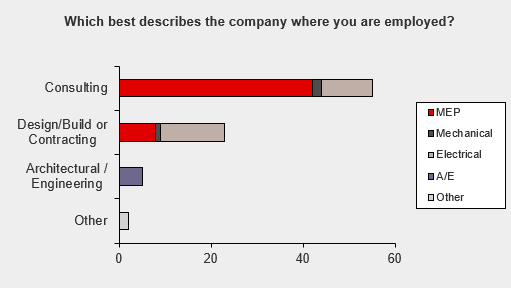
A Possible Downturn, But No Big Changes
This year, the data has borne out that the actual use of BIM not only fell below respondents’ expectations in 2016 for all of the purposes we mentioned, its use in recent years also appears (by our metrics) to be stagnating or decreasing for many uses. This revelation contradicts the prevailing opinion that BIM will be used more often as time passes.
2-5 Person Electrical Design Team in a 20-50 Person Electrical Contractor
